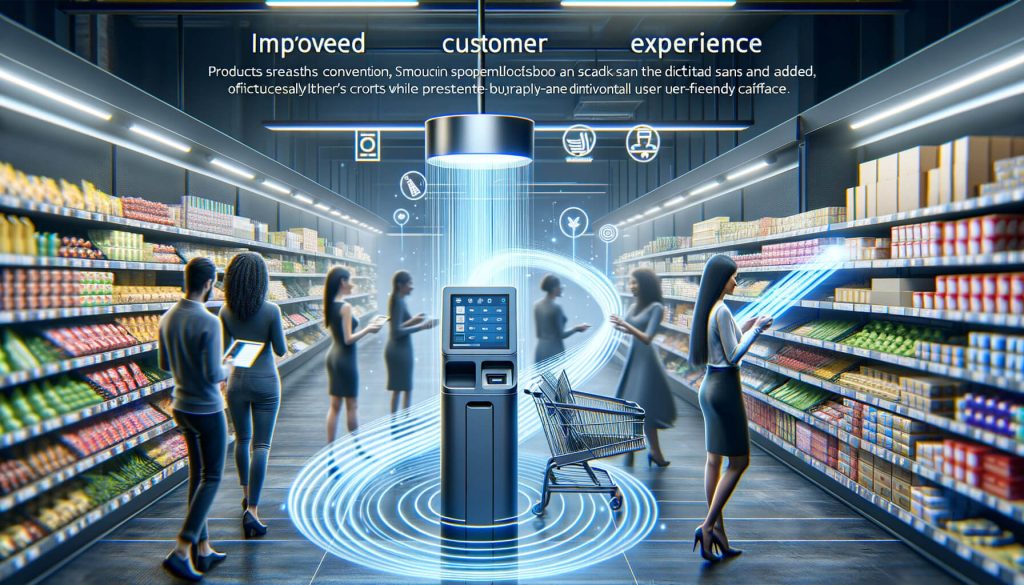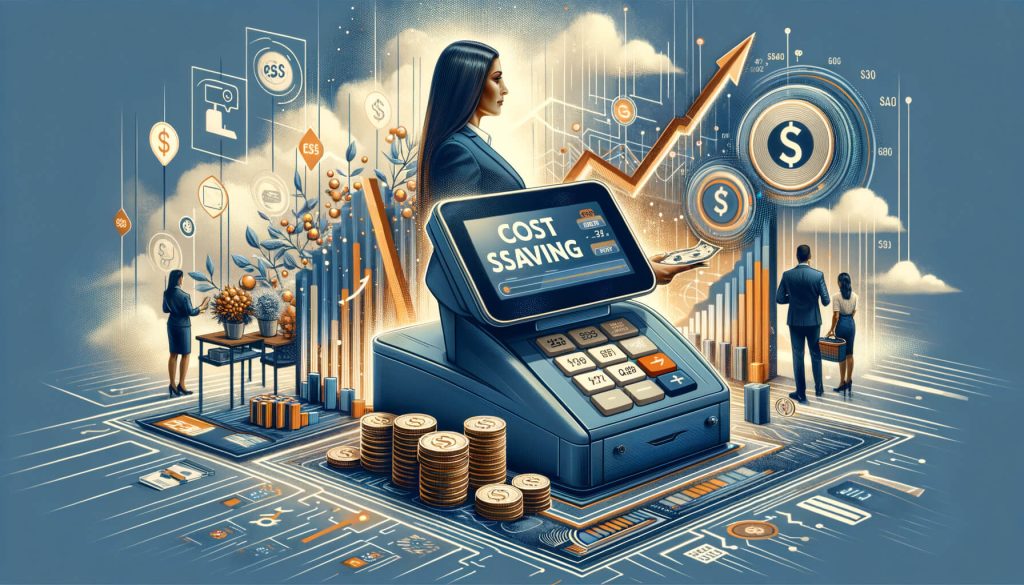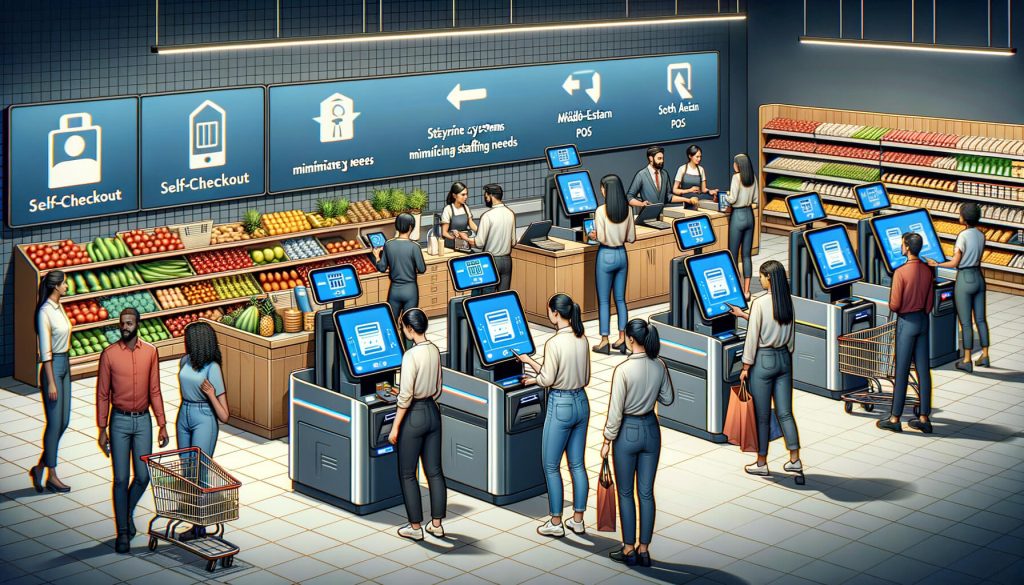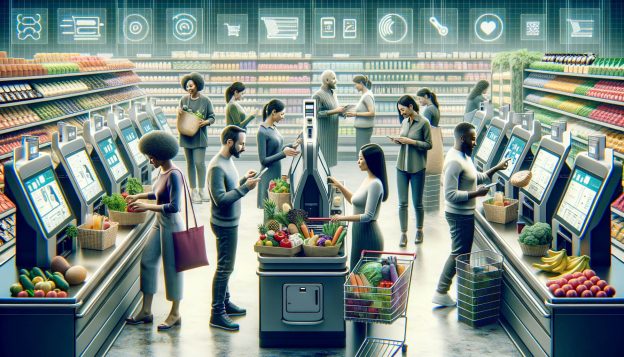In today’s fast-paced world, convenience and efficiency are key factors that drive consumer behavior. This is especially true in the grocery industry, where long checkout lines and crowded stores can often lead to frustration and dissatisfaction among customers. To address these challenges, many grocery stores have turned to self-checkout point-of-sale (POS) systems as a solution.
These systems allow customers to scan and pay for their items themselves, eliminating the need for traditional cashier-operated checkout lanes. In this article, we will explore the benefits of self-checkout POS systems in grocery stores and how they can improve efficiency, customer experience, cost savings, security, operations, social distancing, and loyalty programs.
How Self-Checkout POS Systems Improve Efficiency and Customer Experience

One of the primary benefits of self-checkout POS systems in grocery stores is the improvement in efficiency and customer experience. With traditional cashier-operated checkout lanes, customers often have to wait in long lines, especially during peak hours. This can lead to frustration and a negative perception of the store. However, with self-checkout systems, customers can scan and pay for their items at their own pace, reducing wait times and improving overall satisfaction.
Moreover, self-checkout systems are designed to be user-friendly and intuitive, making it easy for customers to navigate through the scanning and payment process. Many systems feature touchscreens with clear instructions and prompts, ensuring a smooth and hassle-free experience. Additionally, these systems often have built-in barcode scanners and scales, allowing customers to quickly and accurately scan and weigh their items.
Furthermore, self-checkout POS systems can also benefit customers with special needs or disabilities. These systems are often equipped with accessibility features such as larger fonts, audio instructions, and tactile buttons, making it easier for individuals with visual or hearing impairments to use them independently. This promotes inclusivity and ensures that all customers have equal access to the checkout process.
Cost Savings and Increased Profitability with Self-Checkout POS Systems

Another significant advantage of self-checkout POS systems in grocery stores is the potential for cost savings and increased profitability. Traditional cashier-operated checkout lanes require a significant investment in terms of staffing, training, and wages. By implementing self-checkout systems, grocery stores can reduce their reliance on cashiers and reallocate resources to other areas of the business.
With self-checkout systems, fewer cashiers are needed to operate the checkout lanes, resulting in reduced labor costs. This can lead to substantial savings for grocery stores, especially in the long run. Additionally, self-checkout systems can also help to minimize human errors, such as incorrect pricing or missed items, which can result in financial losses for the store. By automating the scanning and payment process, self-checkout systems ensure greater accuracy and reduce the likelihood of such errors.
Moreover, self-checkout POS systems can also contribute to increased profitability through upselling and cross-selling opportunities. These systems can be integrated with loyalty programs and personalized offers, allowing stores to promote additional products or discounts to customers during the checkout process. By leveraging customer data and purchase history, grocery stores can tailor these offers to individual preferences, increasing the likelihood of additional sales and revenue.
Enhanced Security and Loss Prevention Measures in Self-Checkout POS Systems

Security and loss prevention are critical concerns for grocery stores, as theft and fraud can significantly impact their bottom line. Self-checkout POS systems offer enhanced security measures that can help mitigate these risks. These systems are equipped with advanced technologies such as video surveillance, weight sensors, and barcode verification, which help to deter theft and ensure accurate scanning and payment.
Video surveillance is a key component of self-checkout systems, as it allows store personnel to monitor and identify any suspicious activities. Cameras are strategically placed to capture multiple angles of the checkout area, ensuring comprehensive coverage. In the event of a discrepancy or suspected theft, store personnel can review the footage and take appropriate action.
Weight sensors are another important feature of self-checkout systems. These sensors are integrated into the bagging area and can detect discrepancies between the scanned weight and the actual weight of the items. If a significant difference is detected, an alert is triggered, prompting store personnel to intervene and verify the transaction. This helps to prevent customers from intentionally or unintentionally bypassing the scanning process and reduces the likelihood of theft.
Barcode verification is yet another security measure employed by self-checkout POS systems. These systems are designed to verify the authenticity and accuracy of barcodes on items. If a barcode is missing or damaged, or if it does not match the item being scanned, the system will alert the customer and prompt them to seek assistance from store personnel. This ensures that all items are properly scanned and paid for, reducing the risk of theft or fraud.
Streamlining Operations and Reducing Staffing Needs with Self-Checkout POS Systems

In addition to cost savings, self-checkout POS systems can also streamline operations and reduce staffing needs in grocery stores. With traditional cashier-operated checkout lanes, stores often need to allocate a significant number of employees to handle the checkout process, especially during peak hours. This can result in increased labor costs and operational inefficiencies.
By implementing self-checkout systems, grocery stores can reduce their reliance on cashiers and reallocate staff to other areas of the store where they are needed. This can help to optimize labor resources and improve overall operational efficiency. For example, employees who were previously assigned to cashier duties can be reassigned to tasks such as restocking shelves, assisting customers, or providing personalized service.
Moreover, self-checkout systems can also help to alleviate congestion at the checkout area, especially during busy periods. With traditional cashier-operated lanes, long lines can form, leading to delays and frustration among customers. However, with self-checkout systems, customers can scan and pay for their items quickly and efficiently, reducing wait times and improving the flow of customers through the store.
The Role of Self-Checkout POS Systems in Promoting Social Distancing and Hygiene
In the wake of the COVID-19 pandemic, social distancing and hygiene have become paramount in ensuring the safety and well-being of customers and employees. Self-checkout POS systems play a crucial role in promoting these measures in grocery stores. By allowing customers to scan and pay for their items themselves, these systems minimize the need for close contact between customers and cashiers, reducing the risk of virus transmission.
Furthermore, self-checkout systems can also be equipped with additional hygiene measures to further enhance safety. For example, some systems feature touchless payment options such as mobile wallets or contactless cards, eliminating the need for customers to physically handle cash or credit cards. This reduces the risk of contamination and promotes a hygienic checkout process.
Additionally, self-checkout systems can also be integrated with hand sanitizer dispensers or disinfectant wipes, allowing customers to sanitize their hands or wipe down the touchscreen before and after use. This further reinforces hygiene practices and provides customers with peace of mind.
Integrating Loyalty Programs and Personalized Offers with Self-Checkout POS Systems
Loyalty programs and personalized offers are powerful tools for grocery stores to build customer loyalty and drive repeat business. Self-checkout POS systems can be seamlessly integrated with these programs, allowing stores to offer personalized discounts, rewards, and promotions to customers during the checkout process.
By leveraging customer data and purchase history, grocery stores can tailor these offers to individual preferences, increasing the likelihood of additional sales and customer satisfaction. For example, if a customer frequently purchases a particular brand of cereal, the self-checkout system can automatically apply a discount or offer a coupon for that specific brand. This not only incentivizes the customer to make additional purchases but also enhances their overall shopping experience.
Moreover, self-checkout systems can also facilitate the enrollment and management of loyalty programs. Customers can easily sign up for these programs at the self-checkout kiosk, providing their contact information and preferences. This eliminates the need for separate enrollment processes and ensures a seamless experience for customers.
Overcoming Challenges and Ensuring Smooth Implementation of Self-Checkout POS Systems
While self-checkout POS systems offer numerous benefits, their successful implementation requires careful planning and consideration. Grocery stores need to address several challenges to ensure a smooth transition to self-checkout systems.
One of the main challenges is customer resistance or unfamiliarity with self-checkout technology. Some customers may be hesitant to use these systems due to concerns about complexity or lack of assistance. To overcome this challenge, grocery stores can provide clear instructions and signage, as well as dedicated staff to assist customers during the initial stages of implementation. Additionally, stores can offer incentives such as discounts or rewards for using self-checkout systems, encouraging customers to give them a try.
Another challenge is theft or fraud, which can occur when customers intentionally or unintentionally bypass the scanning process. To mitigate this risk, grocery stores can implement security measures such as video surveillance, weight sensors, and barcode verification, as discussed earlier. Additionally, store personnel should be trained to monitor and address any suspicious activities promptly.
Furthermore, technical issues or system malfunctions can also pose challenges during the implementation of self-checkout POS systems. To minimize disruptions, grocery stores should invest in reliable and user-friendly systems, as well as provide ongoing technical support and maintenance. Regular system updates and software upgrades should also be conducted to ensure optimal performance.
Frequently Asked Questions (FAQs)
Q1: Are self-checkout systems faster than traditional cashier-operated lanes?
Yes, self-checkout systems can significantly reduce wait times and improve overall efficiency. Customers can scan and pay for their items at their own pace, eliminating the need to wait for a cashier to process their transaction.
Q2: Can self-checkout systems handle cash payments?
Yes, many self-checkout systems are equipped with cash payment options. Customers can insert cash into the machine, which is then verified and processed automatically.
Q3: Are self-checkout systems secure?
Yes, self-checkout systems employ various security measures such as video surveillance, weight sensors, and barcode verification to deter theft and ensure accurate scanning and payment.
Q4: Can self-checkout systems accommodate customers with disabilities?
Yes, self-checkout systems are designed to be accessible to customers with disabilities. They often feature accessibility features such as larger fonts, audio instructions, and tactile buttons.
Q5: Can self-checkout systems be integrated with loyalty programs?
Yes, self-checkout systems can be seamlessly integrated with loyalty programs, allowing stores to offer personalized discounts, rewards, and promotions to customers during the checkout process.
Conclusion
Self-checkout POS systems have revolutionized the grocery industry by improving efficiency, customer experience, cost savings, security, operations, social distancing, and loyalty programs. These systems offer numerous benefits, including reduced wait times, user-friendly interfaces, cost savings through reduced staffing needs, enhanced security measures, streamlined operations, and the ability to promote social distancing and hygiene.
Additionally, self-checkout systems can be seamlessly integrated with loyalty programs, allowing stores to offer personalized offers and drive customer loyalty. While challenges such as customer resistance, theft, and technical issues need to be addressed, the implementation of self-checkout POS systems can greatly enhance the overall shopping experience for customers and increase profitability for grocery stores.

